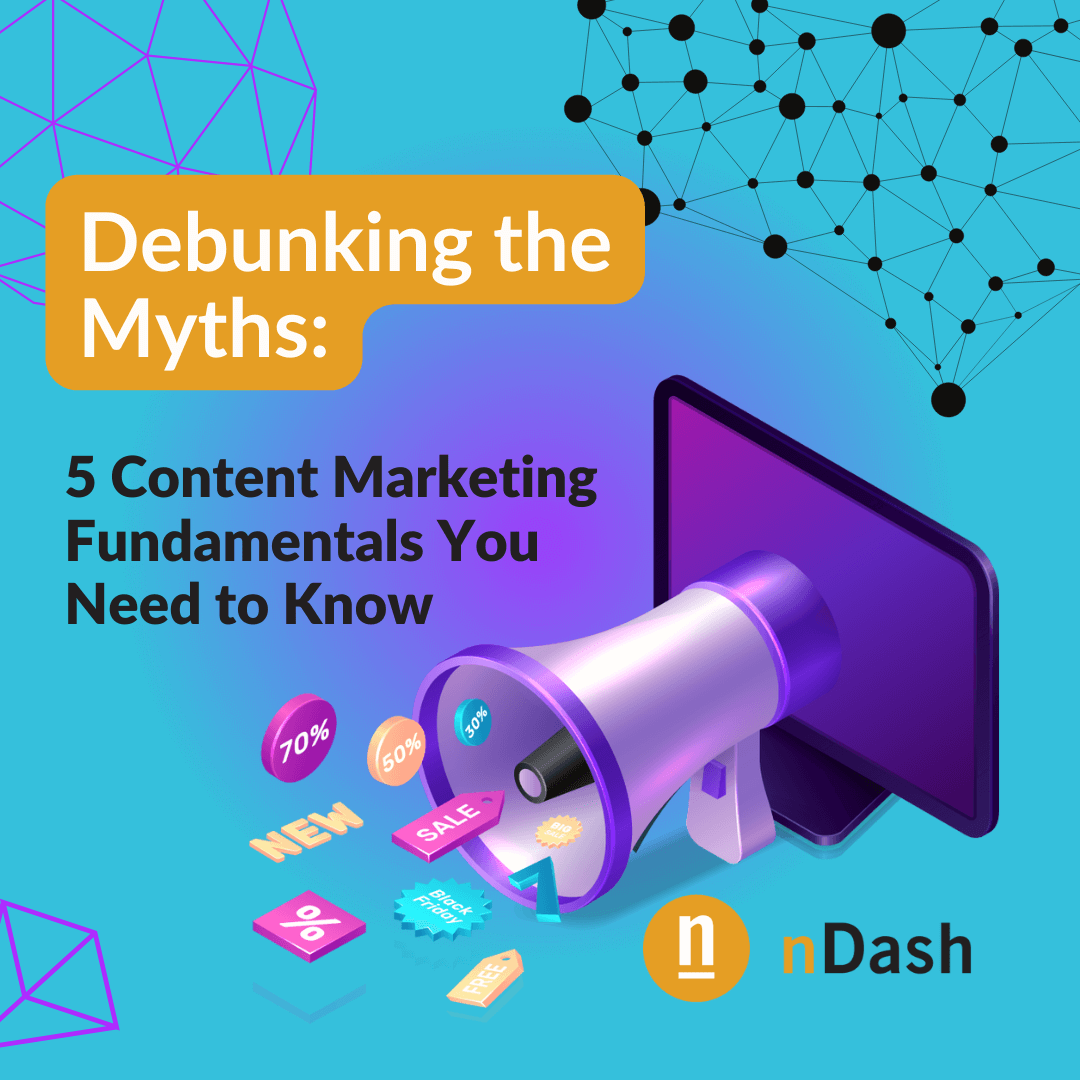With user behaviors changing so rapidly over the past two years and the need for companies to figure out to pivot and adapt, the content marketing landscape has never looked so different.
We live in a digital-first society whereby audiences engage with more content than ever before, making a final buying decision. Consider the 2021 Content Preferences Survey’s results indicating that 30% of respondents consume between one and three pieces of content before engaging with a salesperson, thus making content marketing a priority.
Those survey results further show us that webinars and ebooks rank highest (57%), with white papers coming in at a close second (55%) as the top content formats consumed. In a separate survey conducted by Salsify, we can see that 54% of audiences research product quality, and 42% research customer service before making a buying decision.
What does this mean for content marketing, and the fundamentals you need to know? This guide breaks down those fundamentals to help marketers see how content goes beyond that cliché, “content is king,” and serves as the core of strategies.

Level-Up Content: Create Value That Outpaces the Competition
Myth #1: As long as the topic contains the primary keyword, anyone can produce high-quality and valuable content as part of a content marketing plan.
Debunked: Creating credible, informational, and compelling content is more than performing desk research – it’s also about providing unique insights, backing claims with research, and talking to subject matter experts.
An effective content strategy is a critical component when outpacing the competition, and that starts with understanding the value of content. Creating high-quality content gives your brand the edge — especially when your competitors aren’t offering the same value to their target audience.
In a recent interview, Melisse Lombard, Content Marketing Manager at Hopin, shared, “I’ve been lucky that the organizations I’ve worked for have understood the value of content and its potential for business impact. The content marketing function itself hasn’t always been well defined or understood, and the tools to measure success and impact haven’t always been that straightforward.”
Let’s dive into the top question to ask yourself that’ll edge you and your content creation team closer to leveling up your content.
Does your content provide valuable insights?
There’s no shortage of content available when your target audience does a quick search. And unfortunately, most of it is mediocre – it doesn’t provide the answers they’re looking for or get to the “meat” of their problem.
What’s the solution?
Publish original content that delivers high-value insights to your target audience. That means you’re “showing” your audience how your products and services solve their problems – without being overtly salesy.
The ultimate goals for your content should include:
- Building customer trust
- Building up your brand’s reputation
- Insights that educate your audience
- Fuel for social media engagement
- Proof of your brand’s expertise
- High-quality internal and external links
Does your content address your target audience’s concerns, questions, and other pain points?
When’s the last time you analyzed your target audience? What if I told you that this analysis is the backbone of your content strategy? You’re not publishing the highest-value content if you don’t know who your content speaks to or what answers they need.
And that doesn’t get you closer to closing a deal or securing a sale.
Identifying who your target audience is, their concerns, interests, pain points, questions, preferred social media channels, and other data help you figure out how to reach them effectively. In other words, you’re defining your target groups – or – personas.
Creating personas is beneficial because the process ensures that you’re:
- Only targeting audiences interested in your products or services (Up to 46% of audiences abandon carts if the product information isn’t relevant to them.)
- Crafting personalized content speaking directly to that audience (Research shows that 70% of audiences prefer shopping from personally relevant product pages.)
- Developing and nurturing relationships by addressing their concerns, answering their questions, or solving their pain points
- Edging out the competition by targeting specific audiences, niches, or roles
Does your content provide insights and expertise that only your brand can offer?
When asked, “When creating content, what steps do you take to ensure it’s providing insights and expertise only your brand (or the brand you’re ghostwriting for) can provide,” we received some enlighting responses.
For example, Lori Baer, Ghostwriter, and editor, told us:
“I make sure I have a clear understanding of the brand’s promise, objectives, and target audience. Since I typically ghostwrite for executives, this means their personal brand as well as the brand attributes of the company the individual represents. Style guides and studying existing content are extremely useful to writers. I also listen carefully to those I’m writing for, picking up on what their expert perspective finds important and interesting about the topic.”
She continues, “Then I find the intersection between the given topic and what the brand’s target audience would expect to receive from the brand…the genius people look for in that brand. This gives me the hook to hang the content on. I surround this hook with supporting messages from the brand’s position and expertise to build out content that’s on brand and genuinely useful to the audience. The topic doesn’t have to be unique to the brand, but the perspective about the topic needs to be.”
What else did we learn?
In another response, this time from Jerica Pender, Content Marketing Writer, we learn that she likes to “thoroughly evaluate a brand through the eyes of their customer, even if it means spending HOURS in niche forums and wading through the brand’s collected reviews.”
She continues, “My favorite thing to do is experience the brand/product for myself before I write about it (though I realize this isn’t always possible). In doing my best to become the client persona, I can speak to the audience as a trusted friend in the most natural way. For me, this helps establish respect for the customer and a deeper rapport. After doing this very important preliminary work, I find that addressing pain points, educating the customer, and all of the other things we hope our content achieves comes naturally because of the work done to build an honest and sincere understanding. I guess you could say I approach my content like Method Actor would. But with a keyboard as my mic…”
How are you outpacing the competition by positioning your brand as a valuable resource?
I’ve touched on “outpacing the competition” a couple of times already – let’s dive deeper into what that means regarding brand positioning. Brand positioning gives your target audience a crystal-clear understanding of who your brand serves.
For example, when you visit our content creation platform, you’ll see that we help agencies, marketers, and writers. We can easily break that down into two umbrellas – “For Brands” and “For Writers.” We position ourselves as a valuable resource by publishing content that focuses specifically on these audiences’ pain points.
So, when we target brands, they’ll find content focusing on:
- Content strategies: Including buyer journeys, buyer personas, keywords, SEO, content audits, and brand style guides.
- Editorial planning: This includes blog topics, campaigns, email cadences, social publishing, and content calendar management.
- Content production: This includes blog posts, whitepapers, sales collateral, case studies, social media, and other assets.
Narrowing your brand’s focus shows your audience that you’re the best resource for solving their pain points, and it also shows your audience how you’re setting yourself apart from the competition.
Now, let’s look at specific strategies to incorporate into your content strategy to outpace the competition. That starts with brand positioning – specifically, how is your brand currently positioned? Ask yourself:
- In what ways does your brand differentiate from the competition?
- Does your brand’s current positioning align with your audience’s expectations?
- Does your positioning allow for growth?
- Does your brand make believable and credible promises?
After answering these questions, follow these steps:
Step one:
Conduct a competitive analysis to determine strategic areas to cover within your content strategy. This analysis helps uncover areas where you may or may not be outpacing the competition, like:
- Channel presence
- Content varieties
- Keyword ranking
- SEO performance
- Social media engagement
- Topic coverage
Step two:
Create a positioning statement that clearly describes your target audience and how you want them to perceive and engage with your brand. Here’s a formula to follow when creating this statement:
Our content is where [target audience] gets [brand promise] that offers the following [believable and credible benefits].
Step three:
Put your strategies to work by ensuring consistent messaging throughout every marketing and advertising channel you use.
How to tap into a content creation platform to achieve your goals
You’ve likely heard of content creation platforms – nDash is a good example. These platforms serve as software solutions to help marketers with content creation, organization, optimization, and distribution. Tapping into a content creation platform helps marketers achieve their goals by ensuring their content is targeted, engaging, meaningful, and on-brand.
In a recent interview with eCommerce writer and marketing consultant Kaleigh Moore, she explained, “When COVID happened, and everything shut down two years ago, I had no idea how things were going to go for me. I really felt like, should I get the PPP? Is everybody gonna pull the plug on content marketing? Because it’s often one of the first things to go.”
She continues, “What I found was that people really doubled down on it, which was great for me because events were canceled, and people were looking for new ways to continue marketing, but in a way that made sense. This type of remote work, with the help of freelancers, I think people really leaned into it. That was a great place to be. It kept me very busy.”
Specifically, a content creation platform can help you achieve your goals by:
- Ensuring quality assurance
- Providing you with an elite content creation team of freelance writers
- Tapping into niche and subject matter expertise
- Freeing up time to focus on managing other areas of your business
- Creating targeted content that generates your desired reaction and results
You can read more about how to outpace the competition in this post: Fundamentals: Create Content That Outpaces the Competition
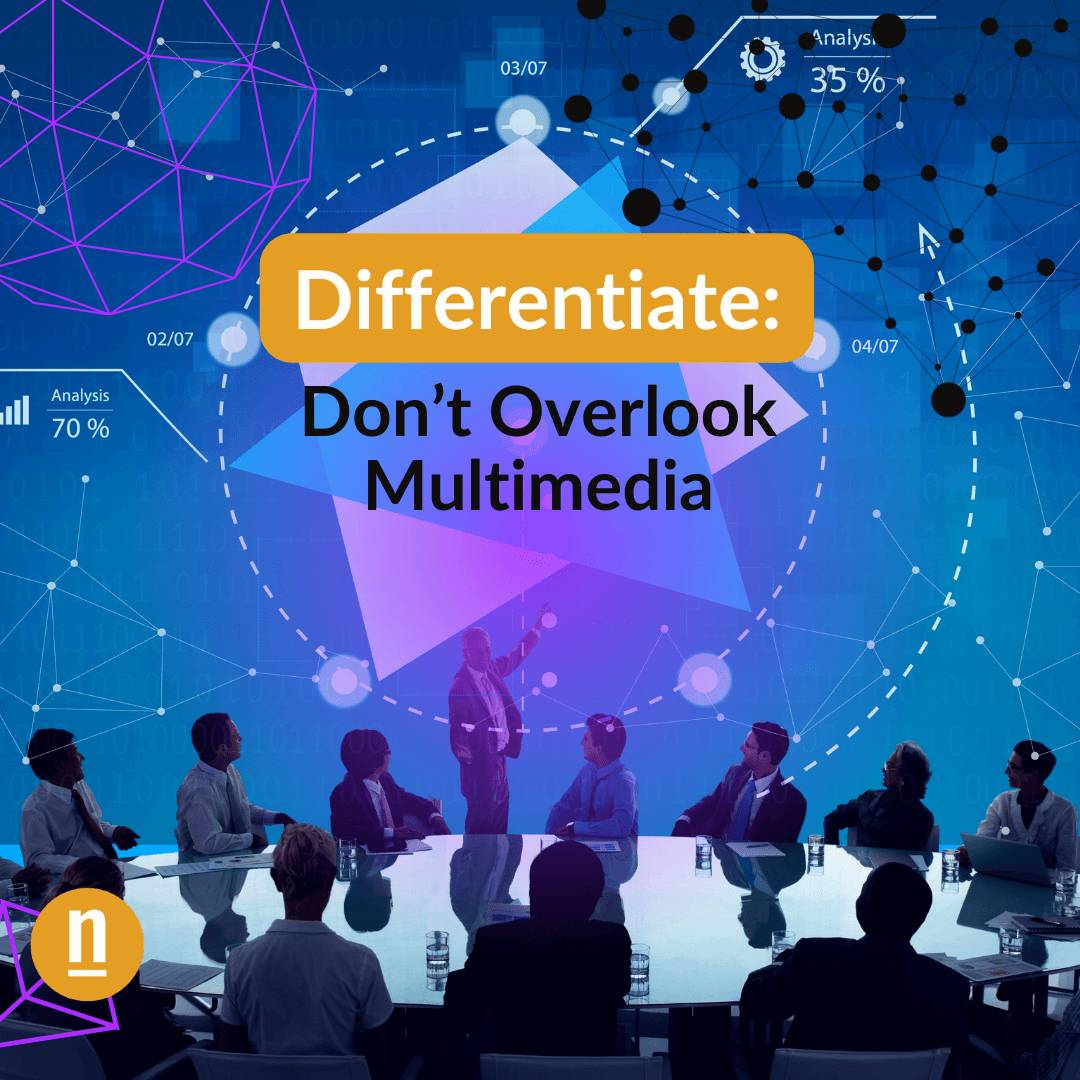
Differentiate: Don’t Overlook Multimedia
Myth #2: Multimedia is too expensive to justify the cost or time investment.
Debunked: G2’s research shows that companies spend between $100 and $1,000 for videos, and, in a separate survey from Venngage, we learn that 24% of marketers spend between 11 and 20% of their budgets on visual content.
Whether you’re creating infographics about data you glean from surveys or writing blog posts about leading innovations in your industry – someone else has done or is doing the same thing. Further adding to those challenges are the ever-evolving changes in buying trends, especially if you’re running a startup. Daniel Glickman, CMO at Roojoom, tells us, “A startup’s biggest challenge, in terms of marketing, is that they may have a very innovative product, but they need to break through the noise of the competition.”
So, how do we differentiate and cut through the competition? The simple answer is – with multimedia. Let’s examine how and why it’s a mistake to ignore multimedia content.
Why ignoring multimedia content is a mistake.
We all want to hook our audience’s attention and increase their chances of engagement, right? A way to achieve that goal is by creating original multimedia content. That means going beyond using stock photography and adding custom charts, images, infographics, slideshows, and videos to your content arsenals.
If you believe creating multimedia content is too complicated or expensive – that’s a mistake. Even if you invest in this content, another mistake is failing to optimize and distribute it properly. However, strategic ways exist to overcome these obstacles and stop ignoring multimedia content.
- Use your smartphone to take photographs and videos of your staff, events, processes, and other aspects of the business.
- Encourage your audience to take to social media to share photographs and videos of them using your offerings.
- Share customer quotes, data points, and photographs in a slideshow
- Work with graphic designers to create high-quality infographics, charts, and image-based presentations
- Record webinars and live streams featuring educational content, slides, and presentation materials
Identify which types of multimedia content your target audiences like engagement with the most

We know blogs and articles are excellent tools for delivering educational content. But, that doesn’t necessarily mean that’s the type of content our audiences want to see. The best way to determine the multimedia content your audience likes engaging with is to understand your buyer’s persona and look at your metrics.
- Step one: Identify and analyze your audience’s search intent to uncover what resonates with them based on click-through rates, comments, likes, shares, and other engagement metrics.
- Step two: Ask your audience directly what types of multimedia content they like engaging with most often.
- Step three: Turn to tools like Answer the Public to determine what questions your audience wants answers to and which channels they’re using to get this information.
- Step four: Compare what you’re doing against the competition to identify trends, create goals, and develop an action plan for reaching your audience effectively.
- Step five: Pay attention to the trends – for example, is your audience spending most of its time on TikTok?
Why now is the time to invest in multimedia content marketing
With 94% of marketers sharing that video helps them increase understanding of their products or services and 81% stating it’s helped them increase sales directly, it’s no wonder embracing multimedia trends is critical. Let’s look at these same survey results to see how audiences use videos:
- 96% use videos to learn more about products or services
- 88% have watched videos that have led them to their buying decision
- 78% state that, after watching a video, they’ve bought or downloaded software or an app
- 73% say they prefer learning about products or services by watching a video
But that’s JUST video content. Let’s look at what other types of multimedia content audiences like engaging with:
- Over half (57%) of Americans regularly listen to podcasts
- After seeing a brand on YouTube, 70% of viewers have bought from it
- Around 40% of marketers plan on increasing investments in virtual conferences, events, and webinars during 2022
- 56% of marketers leveraging infographics state that it’s their most effective content type
Leverage multimedia opportunities across every channel
Levering multimedia opportunities across multiple channels allows content brands and marketers to interact with audiences across numerous touchpoints for a comprehensive content strategy. The best way to fully understand what leveraging means is to look at how multimedia content’s role is during every marketing funnel stage.
Stage One: Attract
The multimedia content you provide provides as much value to your target audience without requiring them to commit. Instead of feeling sales pressure, your audience understands your company’s values and how you can solve their pain points. During this stage, feature educational and how-to video content that shares actionable advice and shows your audience how they can use your company’s offerings.
Stage Two: Engage
During the engage stage of the buyer’s journey, your goal is to identify ways to customize your target audience’s journey as they move through pages on your website. That means ensuring plenty of “next step” places for audiences to convert are on your website. For example, take a high-performing informative blog post and add a supporting video or infographic. Visual learners can learn more about your company’s offerings while you simultaneously increase your brand’s engagement and reach.
Stage Three: Delight
This stage is where you’re “delighting” your prospects by showcasing highly targeted CTAs, requesting feedback, interacting with them on social media, and crafting personalized messages. Multimedia opportunities include creating personalized video content. For example, entertaining videos help your target audience see your brand’s personality while showing how you intend to support them. Show your audience how much you value them and want to nurture lasting relationships by creating a “thank you” video.
You can read more about the importance of not overlooking media in this post: Fundamentals: Don’t Overlook Multimedia

Challenge Your Content Marketing Team to be Consistent
Myth #3: It doesn’t matter how often we publish content as long as we get “something” on our channels now and then.
Debunked: Consistency is critical for how your brand and its offerings rank on search engines – without continuity, it’s challenging for your target audiences to recognize who you are or what you offer.
Remember, how your brand acts, looks, and sounds directly impacts your target audience’s perception. That means ensuring your brand’s messaging is consistent in all content you and your team create. That’s just one part of maintaining consistency, though. How much (and how often) your content marketing team creates content also plays an integral role in maintaining consistency.
In an interview, Andy Krainak, Brand Director of Gary Vaynerchuck, explains, “The hardest thing is coming up with something new every day; it takes a certain type of creativity.” No matter how often you and your team decide to publish content, it must follow an editorial and social media calendar. Maintaining these schedules prevents customer confusion and ensures they have a better experience with your brand.
Why blogging is a vital part of your customer’s journey
At the time of this writing, over five million blog posts were written – with that number growing by the second. And according to Optinmonster, over 400 million people view over 20 billion pages monthly. Those statistics further reveal that blogs rate as the fifth most trustworthy source when consumers research online for information.
But why is blogging a vital part of your customer’s journey? Audiences typically read blog posts to:
- Discover industry news or trends: While some research about products or services might occur, audiences also want to read blogs covering the industry in which those offerings are associated.
- Find entertainment: Searchers want content that makes them laugh, intrigues them, or tells them interesting stories.
- Learn something: People search for how to do things and gather facts daily.
- Solve a problem: When audiences experience a problem, they typically look online for a solution.
So, when your target audience finds your blog – are they finding information that helps them understand your products or services? While you shouldn’t inundate your readers with brand-specific content, sprinkling it into updates in moderation helps them learn how your brand can solve their problems.
Avoid focusing only on company news.
Even though it might seem interesting to you or your team, readers don’t care about “high-five” situations. Save that content for social media. Instead of reading about who received a promotion, they’d prefer reading content that helps them solve a problem. Think about it this way – if your blog talks primarily about your company, you’re not covering topics relevant or helpful to your audience.
What’s the solution?
Talk to your sales team to identify what questions prospects ask most often. Each question could be a potential blog post. By taking this approach, you’re helping your target audience address specific concerns before deciding to purchase. Here are some blog topic ideas you can use to connect with your audience:
- Comparisons and “best of” lists
- How-to and tutorial articles
- Benefits and drawbacks of products or services
- Answer cost and price questions
- Product or service reviews
Does your blog content answer questions your customers ask in a search?
It’s so much easier for consumers to find answers to their questions – they can hit up “question sites” like Quora, Tweet their questions out, or use their favorite search engines. With that in mind, brands must focus on how their content aligns with the questions their customers ask.
For example, when looking at Google’s search results, consumers can find:
- Featured snippets: Google positions this content at the top of search engine page results to highlight quick answers in a search.
- People also ask: Google positions this list of questions in various places in a search to showcase the most common questions other searchers ask about a given topic.
Think strategically about the best ways to answer your target audience’s questions. That could mean including a FAQ at the bottom of each blog post highlighting and summarizing content. Or, you could create comprehensive FAQ pages throughout your website that dive deeper into specific help topics and your brand’s offerings.
Understand the power of blogging frequency in your content marketing plan
When asked in a Twitter and LinkedIn poll, “How often do you update your blog (daily, weekly, monthly, or whenever I think of it),” 53.33% of respondents stated that they update their blog whenever they think of it.
Dawn Colclasure, Experienced Writer, editor, and ghostwriter, told us on Twitter that she has more time on the weekends. She says, “I usually write the post then let it sit for a day or two. Just so I can think more about it or in case anything else comes to mind. Then I go back to look it over again, and sometimes I will make changes or add something. Then I will give it one last read before posting.”
On LinkedIn, we received the following response from freelance writer Debra Blackwell, “If you update your blog daily, you may not receive a substantial amount of traffic. However, when your audience knows they have a new weekly article to read, they will be more likely to be excited!”
The bottom line – the frequency at which you update your blog depends on what’s best for your brand and your audience. For example, your goals might look like this:
- Increase organic traffic: Post new and updated content four or five times weekly.
- Increase brand awareness: Post new and updated content at least three or four times weekly.
How a content creation platform can help maintain consistency
Challenging your team to maintain consistency requires focus and planning, both of which are possible with a content creation platform. For example, on nDash, you’ll have access to tools and features specifically designed to help you achieve these goals:
- Freelance marketplace: Open and transparent access to over 10,000 writers that meet requirements for any topic at any budget
- Advanced workflows: Access to a content calendar, content management, and publishing tools
- Content ideation: Receive direct ideas, request ideas using open calls, and browse our idea marketplace
- In-house teams: Streamline content delivery, ideas, and collaboration by adding as many writers from your company as you need
- Billing and payments: Pre-fund an account, pay writers on-demand or use NET-30 invoicing.
- Customer success: We play an active role in helping you understand the platform and build the best writing team
Learn more about challenging your team to be more consistent in this post: Fundamentals: Content Marketing Team Consistency

Leverage Customer Case Studies: Personalization and Expertise
Myth #4: Case studies don’t provide enough value to add them to a content strategy.
Debunked: Over 80% of consumers research products or services before making an online purchase.
Customer case studies are documented stories your customers tell about how your company’s offerings helped them solve a problem. They differ from testimonials because they’re long-form content featuring challenges, solutions, and positive outcomes. By filling these stories with data points and quantitative results, you can amplify customer case studies and make them more compelling.
According to a survey by Power Reviews, 98% of consumers believe reviews are an important resource during the decision phase of their buyer’s journey. Showcasing case studies on your website allows you to create personalized experiences when your target audience seeks expertise. You can show them how your offerings work through brand storytelling and creating a human-to-human connection.
Melissa Stevens, Director of Digital Marketing at BitSight Technologies, explains, “One tactic on the B2C side that B2B is adopting successfully though is the ‘human to human’ approach through personalization. Treating our buyers like people instead of businesses, and targeting based on expressed interests and behaviors is a really great tactic that companies are adopting more and more.”
The benefits of leveraging customer case studies in email content marketing campaigns
If you have a segmented email list, leveraging customer case studies in your email campaigns is a win-win. For example, if you have case studies from clients in the construction industry, sending them to your segment of construction-related email contacts is an effective way to nurture those leads. This approach provides prospects with social proof to help them determine if your offerings are the best choice.
Leveraging case studies in your email marketing campaigns is beneficial because they:
- Demonstrate how comfortable your brand is in a specific industry or niche
- Show your brand’s familiarity with providing solutions for industry-specific needs
- Highlight your brand’s ability to provide expertise and targeted results
The importance of creating a dedicated case studies page
Whether you call them customer success stories or case studies, they should be easy for visitors to find. By publishing them on a dedicated case studies page, you’re showing your target audience a variety of stories from relevant industries.
There’s no point in creating a directory of case studies if they’re too hard for anyone to find. Featuring them on a dedicated page also creates linking opportunities in blog posts, email newsletters, product or services pages, and social media posts.
How to repurpose case studies into other valuable and shareable assets
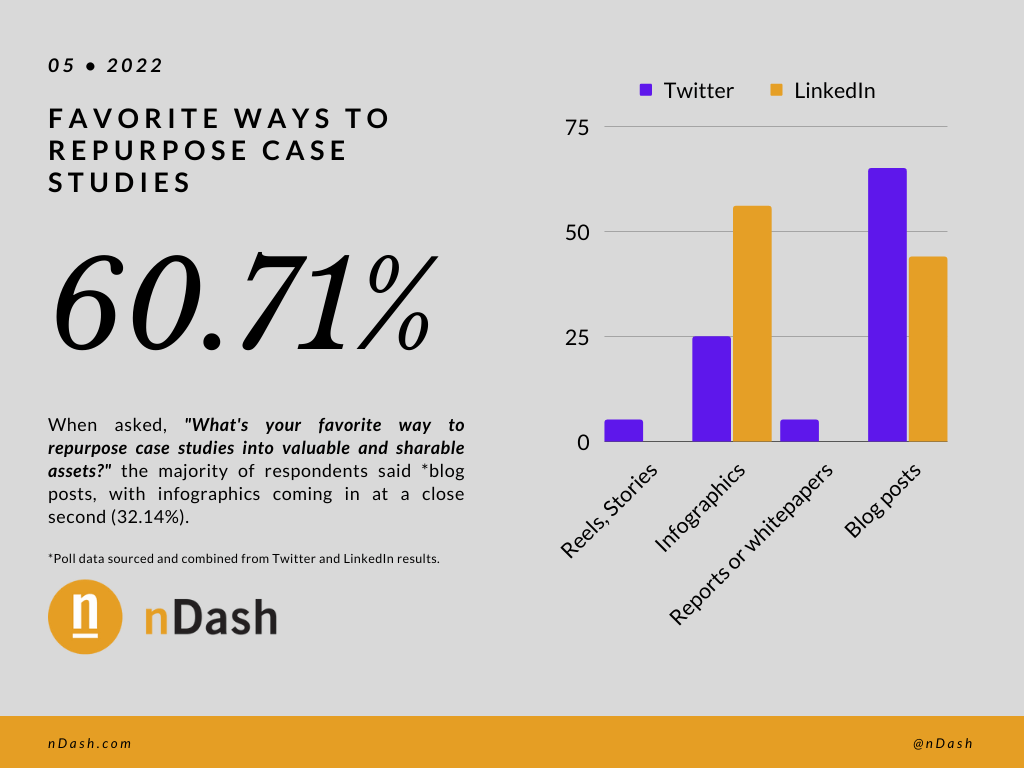
We turned to social media and asked, “What’s your favorite way to repurpose case studies into valuable and sharable assets?” Respondents chose from reels and stories, infographics, reports or whitepapers, and blog posts. Survey results reveal that over 60% of respondents prefer repurposing case studies into blog posts.
Roy Sarkar of Roy Writes Content shares why he prefers blog posts, “Answered blog posts because you can repurpose them into a shorter asset (hopefully with a different perspective) to drive web traffic, easier sharing, SEO boost, etc. Also like pitching to media outlets, especially if the customer’s onboard with more info (more value to them).”
John McTigue, a freelance B2B strategic writer and strategist, prefers reals and stories, “Reels, stories FTW. Take the most insightful bits (one question, one answer) from your podcast or webinar, repurpose them into social posts, and add them to your resources page. Link them from relevant blog posts and use the clips to illustrate points. Much more bang for the buck this way. Social posts alone will probably get much more engagement than the original content.”
We also heard from Rachel Burger, a B2B SaaS content writer, about why she likes using infographics. She explains that all of them have value, but infographics would win out if she had to choose. “If I had to choose, “infographic” wins out because you now have a text-based piece of content AND a long-form visual asset, both of which can be chopped up further for sharing. Ideally, you’d do much more than that with your repurposing plan, though.”
Getting the most bang for the buck by incorporating customer case studies into social media campaigns
Leveraging customer case studies into social media campaigns is an excellent way to show “social proof” to prospects when determining if they’re making the right choice. Here are some tips for getting the most bang for your buck by adding case studies to your social media campaign:
- Highlight quotes, data points, ROI, and other snippets
- Tag clients in the post to expand its reach
- Clearly communicate the customer’s pain points and results
- Pin the social media post to the top of your feed
Avoid using generic commentary on these social media posts. For example, instead of writing, “Check out our latest case study by following this link,” use actionable content. Here’s an example of what that looks like:
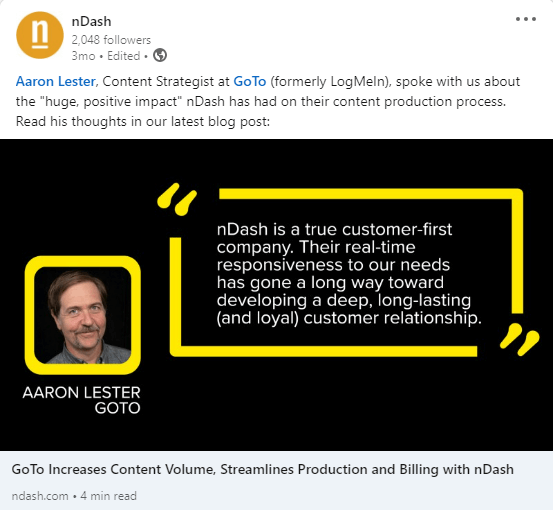
In this example, we feature a snippet of the results Aaron Lester from GoTo mentions in the case study in the post’s text. Then, we coupled that with a quote pulled from the case study in the post’s graphic.
Learn more about leveraging the power of customer case studies in this post: Fundamentals: Leverage Customer Case Studies
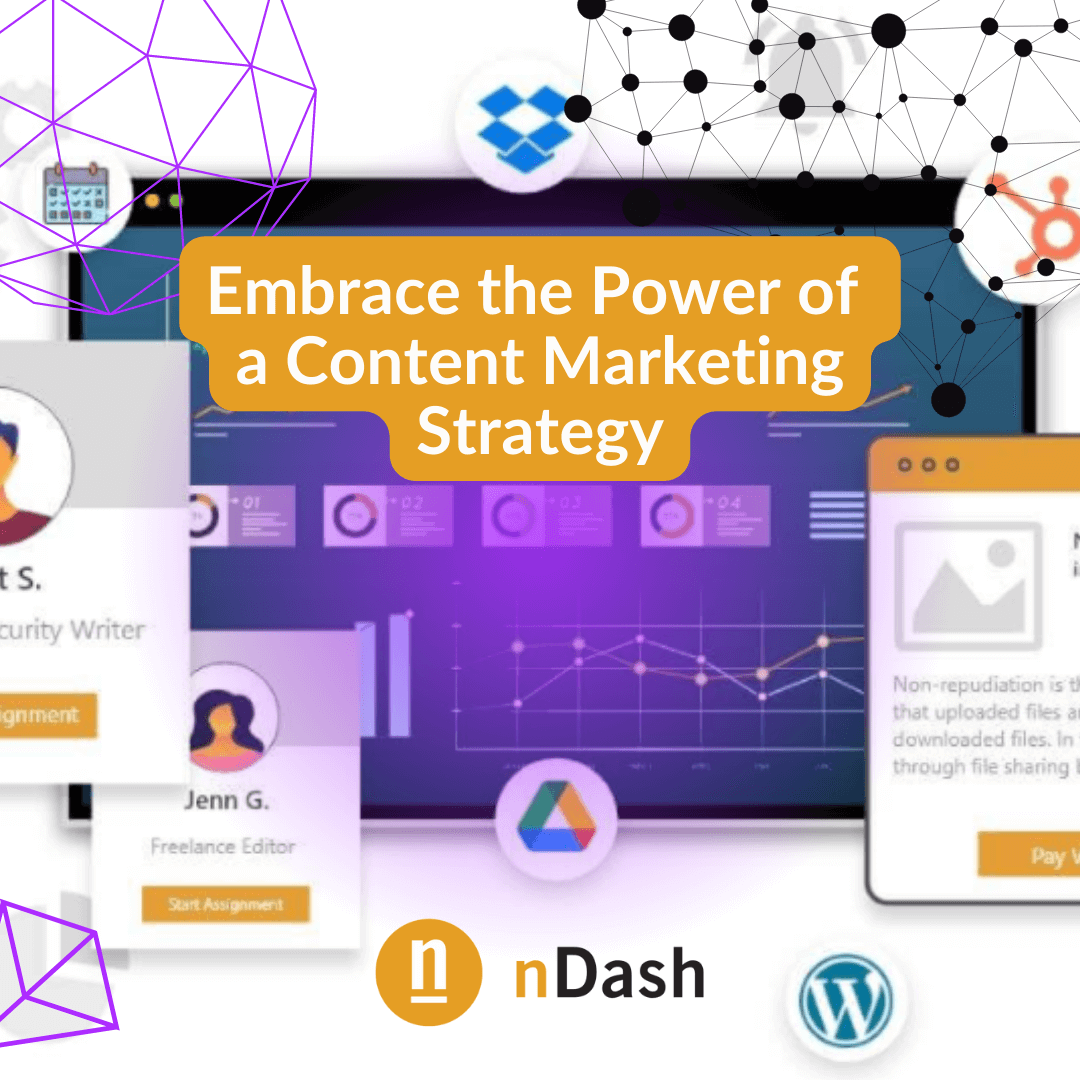
Embrace the Power of a Content Marketing Strategy
Myth #5: We don’t need a content strategy as long as we keep up with and post about the latest trends.
Debunked: Content strategies help brands define their marketing goals, plan their work, set priorities, and receive tangible results.
Before discussing the importance of a content marketing strategy, let’s look at its definition. These strategies are a well-planned approach to showing your target audience who you are, why they should care, and how you can solve their pain points.
Amahl Williams, Vice President of Business Development for Pluris Marketing, explains, “Your marketing strategy should be informed by analytics, not data. Even with 8,000 marketing platforms, if people don’t know how to use them to actually improve their business, then what’s the point?”
The importance of having a documented content strategy
There are three pillars of a documented content strategy – why (goals), who (target audience), and how (brand mission). Nicole Bump, a Fractional Content Director, explains, “A solid content strategy should outline what you are producing, why you’re producing it, who it’s for, and exactly what to look out for to measure your progress. When your content strategy is built this way, you naturally refer back to it often, which helps everyone to stay on track.”
A documented content strategy helps brands achieve goals like:
- Building their brand’s awareness
- Growing email lists
- Finding and engaging with new audiences
- Increasing their website’s traffic
How content strategies help with content development and efficiency
Content development is easy to define – it’s simply the process of creating new content. Content strategies help with content development and efficiency by:
- Identifying your brand’s target audience and the content they want to consume
- Brainstorming topics to write about or create other content for based on keyword research and ideation
- Prioritizing topics by impact and relevance
- Outlining the structure and other requirements in a content brief
- Plotting where the content will fall on an editorial calendar
- Organizing the content creation and editing process
Creating a repeatable and efficient process will save a considerable amount of time. Further enhance your content development process and its efficiency by adding templates, content briefs, and workflows to your content marketing strategy.
Use content strategies to reach your target audience
Successful content strategies attract a brand’s target audience at every stage of the buyer’s journey. This engagement lasts long after your customers make a purchase. Because your business might target more than one customer, your content strategy should attract more than one type of audience. Ask yourself the following questions:
- Who is my target audience, and, if there’s more than one, what are they?
- What problem does your brand’s offering solve?
- How does your brand set itself apart from competitors?
- What content formats does your target audience like to consume the most?
- What channels does your target audience spend the most time on (blogs, social media, etc.)?
- What’s your plan for managing the content creation process?
You can reach your target audiences more successfully by answering these questions, among others, in your content strategy. Start by defining your goals, conducting persona research, running a content audit, choosing a content creation platform, identifying the best types of content to create, and brainstorming ideas.
How content strategies optimize outcomes and improve ROI
When done well, content strategies optimize the outcomes for every aspect of your brand’s content marketing efforts. Every piece of content your brand creates should work toward reaching your overarching goals – otherwise, what’s the point of creating it?
Remember, the point of a content strategy isn’t mapping out everything you intend to post or publish over the next year. Instead, look at it as a living document that changes as your business grows. These plans establish the parameters necessary for staying on track and achieving your goals.
Regarding improving ROI, content strategies help you organize your time and effectively allocate resources because you know your content needs ahead of time. These plans give you insight into where you can improve the content development process, create compelling content, and prevent your ROI from suffering.
Continue reading about how to leverage content marketing strategies here: Fundamentals: Content Marketing Strategies
WRAPPING UP: Content Fundamentals You Need to Know
We’ve covered a lot of information here, but the bottom line is that there are many myths floating around that could damage your content marketing efforts. Understanding the content fundamentals you need to know means figuring out how to level up your content, differentiate, be consistent, leverage customer case studies, and embrace the power of a content strategy.
Nail down these fundamentals by contacting our sales team, engaging with our freelance community, and learning more about how our platform’s content creation services can help your brand succeed.
FAQ
What are the five essential elements of a content marketing strategy?
Every content marketing strategy consists of five essential elements, including:
- Target audience
- Goals
- Brand voice
- Distribution channels
- Tactics
What are the fundamentals of content marketing?
The five fundamentals of content marketing include:
- Level-Up Content: Create Value That Outpaces the Competition
- Differentiate: Don’t Overlook Multimedia
- Challenge Your Content Marketing Team to be Consistent
- Leverage Customer Case Studies: Personalization and Expertise
- Embrace the Power of a Content Marketing Strategy
What are the five types of content?
While there are more than five types of content, there are some that perform better than others. Examples of five types of content include infographics, blog content, podcasts, videos, and social media content.
